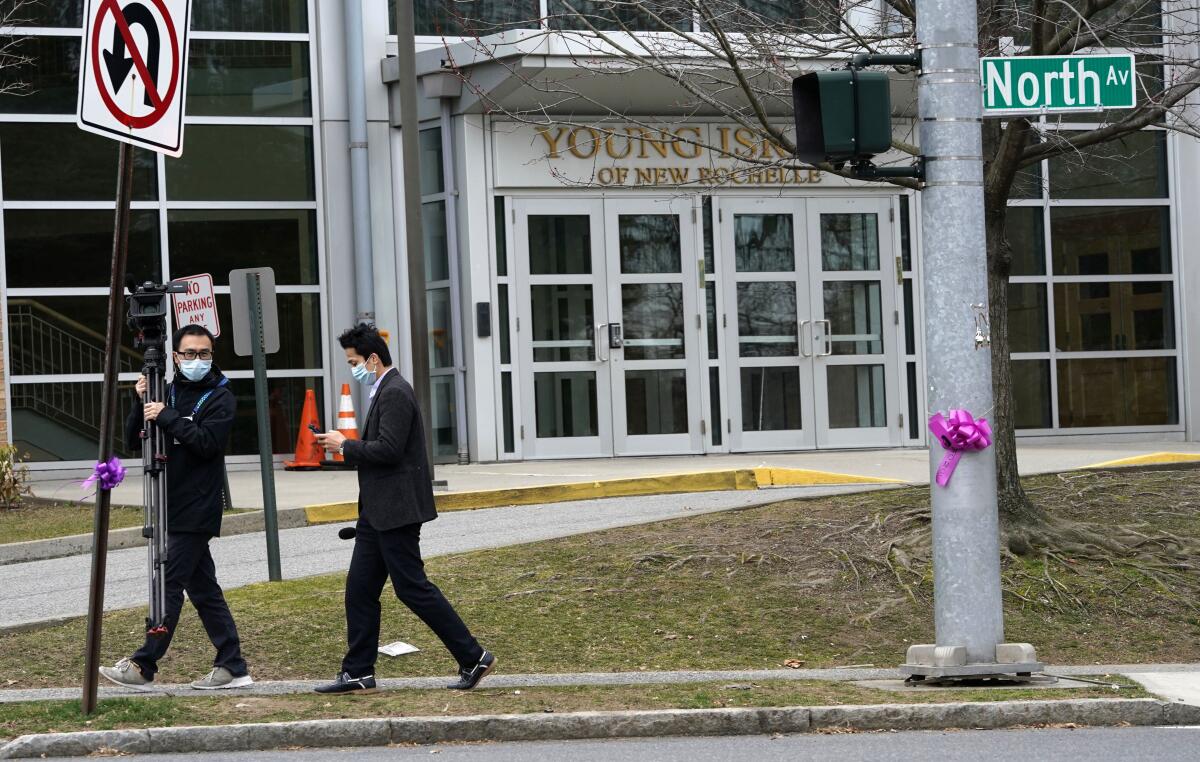As California retreats from containment, New York sends in the National Guard

- Share via
In New York, Gov. Andrew Cuomo sent the National Guard to a suburban enclave northeast of New York City to prevent COVID-19 from infecting more people there, after 108 residents tested positive in recent days.
In Santa Clara, where California is experiencing its largest outbreak of the virus with 45 positive cases confirmed, health officials continued to direct residents not to congregate, following a ban on large events earlier this week.
In Sacramento, the county health officer announced there would be no more quarantines and minimal tracing to determine how those testing positive for the novel coronavirus contracted the deadly, fast-moving disease. Those with symptoms face only voluntary restrictions for mingling in the community.
“The cat is already out of the bag,” said Peter Beilenson, Sacramento County’s health director. “The community spread has already occurred.”
The health director made his comments before the county revealed Tuesday that a woman in her 90s had died of COVID-19 in an assisted living facility home south of Sacramento, making her the third confirmed case of a Californian dying of the disease.
It was further evidence, as many health officials argue, that the novel coronavirus will not easily be contained. From using military might to a seemingly hands-off attitude, hard-hit states and municipalities hope to slow the spread of a contagion that threatens lives and can overwhelm health systems if too many cases hit at once.
This week, as the number of people testing positive begins to grow daily, health officials across the United States are taking varied tactics as they make the switch from containment to mitigation — a transition mandated in part, say some experts, by a failure to find cases earlier as testing was delayed by a lack of access to kits, a problem many argue is still impeding efforts.
“Our detection is so poor that if we detect one [case] we absolutely have a lot more than that,” said Marc Lipsitch, a professor of epidemiology at the Harvard School of Public Health. “We have failed to detect cases to such a degree that there are probably many, many cases that are spreading undetected and the only way to deal with that problem are measures like social distancing that don’t require tracing cases.”
A woman in her 90s has died of the novel coronavirus in a northern California assisted-living complex, sparking fears of an outbreak among other residents of the facility.
What this new phase of fighting the novel coronavirus looks like varies widely as health officials grapple with how to keep people away from one another, a daunting prospect when many Americans are unaware, or skeptical, of the actual risks of the disease. Mixed messages from federal, state and local authorities have confused many about the suggested precautions they should take, said Lipstich and others.
“I don’t think that people are grasping that it’s serious right now,” said Harvard epidemiologist Michael Mina. “And I think right now is our last chance to prevent massive numbers of cases.”
President Trump has shifted between sounding skeptical about the virus to claiming the contagion is largely under control.
“I think we’re doing a really good job,” Trump said Tuesday after a meeting with GOP leaders on Capitol Hill. “Democrat governors are saying we’ve done a fantastic job ... Gavin Newsom said there’s not a thing that he’s asked for that we weren’t able to get him.”
But the same day, Surgeon Gen.l Jerome Adams said at a White House briefing that, “We will see more cases. Unfortunately, we are likely to see more deaths. We have not seen the peak of this epidemic quite yet.”
Mitigation strategies attempt to minimize the virus’s impact on the broader community, especially vulnerable populations, through community actions — rather than a focus on exposed individuals.
But it carries its own costs. When authorities urge businesses and governments to delay events like Coachella, as happened Tuesday, it mitigates risks but also hits low-income workers, who are losing jobs, contributing to the chance the nation will slip into a recession.
“In most jobs in this country, you can’t work from a laptop on your couch,” said Adriane Casalotti, the chief of government and public affairs at the National Assn. of County and City Health Officials. “We’re out there asking real people to choose between the public’s health and their own financial well-being — them keeping their jobs. For individual families, this is complicated and messy.”
The disparate realities of mitigation are especially apparent in California, where Gov. Newsom has made it clear counties have the lead in responding to the virus.
“What we are doing is a bottom-up process not a top-down process,” said Newsom Tuesday. “I think the local health officials should make those determinations.”
In Los Angeles County, Barbara Ferrer, director of the county Department of Health, said her agency also had a focus on slowing the spread, but is combining mitigation with containment.
Public health officials in Placer and Yolo counties, which neighbor Sacramento to the northeast and west, also announced a shift Tuesday from trying to contain COVID-19 to accepting that the disease is spreading too fast for widespread quarantining measures. Seven people in Placer County have tested positive for COVID-19, including a Rocklin man who died last week. Yolo County has one confirmed case.
On Tuesday, the United States surpassed 1,000 coronavirus cases, mostly in Washingon state, New York and California. As of Tuesday, California had 157 confirmed cases of COVID-19, with more than 1,075 Californians so far tested for the coronavirus at 18 labs across the state, the governor said.
Under the new recommendations in Placer and Yolo counties, which are effective through March 31, individuals who have come in contact with a confirmed or suspected case of COVID-19 will no longer be required to be quarantined for 14 days. Instead, persons with cold-like symptoms, regardless of whether they have the coronavirus or flu, are asked to self-quarantine and manage their symptoms with over-the-counter drugs.
The counties also said while they have tests for COVID-19, they will be reserved for those with more serious symptoms, since mild symptoms are treated the same regardless of the diagnosis. The counties urged businesses to allow employees to telecommute where possible and for large events to be postponed or canceled.
Aimee Sisson, Placer County’s public health director, said the county will continue to do some tracing of who came in contact with COVID-19, but only to screen for high-risk situations, such as a person who visited a nursing home or came in contact with an immune-compromised individual.
Widespread quarantine measures can’t be sustained, Sisson said, especially for healthcare workers. California is already taxed with a shortage of medical providers, and forcing quarantines on front-line staff is a burden the system can’t bear as the virus spreads.
If counties keep quarantining healthcare workers for potential exposure, “we wouldn’t have any healthcare workers left,” she said.
Sisson added that the county does not have the capacity to continue to trace every contact because it lacks the manpower, even with an offer from the state for additional help.
“Even a handful of cases tested our capacity,” she said.
Casalotti said that in addition to tracing contacts, health officials felt burdened by containment because it required caring for those in isolation — a costly and labor-intensive prospect. Health workers often deliver groceries to keep patients away from busy public spaces where they could transmit the virus, for example.
“It’s hard work to do even when the numbers are in the hundreds,” said John Auerbach, the chief executive of Trust for America’s Health.
But Dr. Stanley Perlman, a microbiologist at the University of Iowa who studies coronaviruses, pointed out that drastic measures in Wuhan seem to have significantly slowed the spread of the virus. China’s massive quarantine was a never-before-seen public health experiment.
“Certainly what they did seems to have worked,” Perlman said.
A study released last week in the journal Science modeled the effects that Wuhan’s travel quarantine had on the rest of the globe. Though the study found minimal impact in stopping the spread of COVID-19 to the rest of China, researchers found that there were 77% fewer cases imported to other parts of the world through mid-February due to the restrictions.
Because of its success, it has become the map for how to combat these outbreaks. Italy locked down the nation of 60 million people this week.
But Perlman said that it is hard to believe that Americans would follow such orders — the challenge health officials will face as they craft their plans.
“This is not an on-off switch. It’s a dimmer,” Dr. Nancy Messonnier, the director of the CDC’s National Center for Immunization and Respiratory Diseases, said Monday of efforts to shift strategies.
Still, World Health Organization officials have warned against countries giving up on containment strategies entirely.
WHO director Tedros Adhanom Ghebreyesus said that several countries in Asia have shown that even places with huge outbreaks can control the disease’s spread. He said government leaders have a responsibility to take action swiftly, especially in countries with major outbreaks.
Tedros said he is heartened by Italy’s aggressive measures to contain the virus.
“The bottom line is: we are not at the mercy of the virus,” he said. “It is never too late to turn back the tide of the virus.”
Tedros said countries with community spread do need mitigation, including considering drastic actions, such as closing schools and churches and canceling mass gatherings. But, he added, all countries need to do contact tracing as well.
“No white flag. We don’t give up. We fight to protect our children, to protect our senior citizens,” he said. “A comprehensive approach, a blended approach, an approach that can help contain this outbreak is very important because the death rate from this outbreak is high.”
Staff writers Chris Megerian, Thomas Curwen and Taryn Luna contributed to this report.
More to Read
Sign up for Essential California
The most important California stories and recommendations in your inbox every morning.
You may occasionally receive promotional content from the Los Angeles Times.














